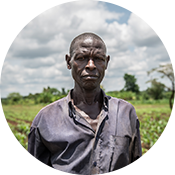Identifying an area of great human need
We seek to address root causes of human need or, at least, challenges that if not addressed greatly limit life prospects. Recognizing that we cannot address all challenges – and because each program we add to our portfolio creates a substantial, incremental monitoring and reporting obligation – we avoid duplication and work to construct a diverse menu within a relatively short list of offerings. Once we identify an area of possible Focusing Philanthropy involvement, we conduct our own research and augment it with input from experts within our broad network of individuals and institutions. In this way, we test the premise that our kind of philanthropy can be effective and learn about the kinds of interventions that others have employed.
Here are just two of many examples of the starting points from which we work:

Over half of all the poorest people in the world have one thing in common: they are subsistence farmers.
From this starting observation, we sought to find a proven, scalable program that moves these people permanently out of starvation poverty. We now support One Acre Fund that is accomplishing this goal, with our help, across growing geographies and at significant scale.

There are 400,000 foster youth in the child welfare systems of counties across the United States.
After they “age out,” usually at age 18, a high percentage become homeless, pregnant, and/or enter the criminal justice system. Very few go to college; hardly any graduate. We sought an effective intervention to help get foster youth out of the system and into loving, stable homes as quickly as possible – and to see that those who stayed in the system had an informed advocate. This led us to find, evaluate, and actively support Court Appointed Special Advocates (CASA).
Finding Effective Interventions
Once we have identified and evaluated an area of human need, we search for the points of intervention where the greatest impact is possible by private philanthropists. This gives us a lens through which to look at possible intervention alternatives and implementing partners.
Selecting Implementing Partners
Only after we have selected an area of human need that we think we can effectively address, and after we have identified potential philanthropic intervention points, do we look for implementing partners and programs. All our partners must have a proven record of delivering life-changing results, demonstrate the institutional capacity to scale as they gain additional support, and be prepared to partner with us. Importantly, they must understand the difference between activity and impact – and be committed to delivering (and reporting on) real results. We do not consider organizations whose primary missions involve either proselytizing or public policy advocacy.

